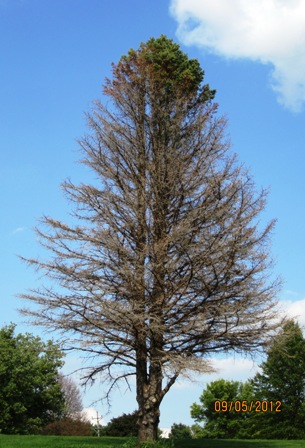The Colorado Spruce is a slow growing (6-12 inches per year) evergreen that has a needle that can be green, bluish, or bluish silver that are about 1 inch long. Color can be very variable and the needles are very sharp and can really “poke” when mowing around larger plants. It does not shed its needles but keeps them for 10 years or longer, with its branches extending to the ground. This tree is a native of the high plains, low humidity areas from New Mexico to Wyoming.
It will grow to 60 ft tall and 15 ft wide and is very wind firm due to its large spreading root system and tough flexible wood. This tree can live a long life (100 years+) in its native area, outside of that it varies greatly and many times live no longer than 25 years. In the wild around Durango, Colorado many spectacular species grow over 100 ft tall. Due to its shape, heavy snow and ice storms cause little damage. Deer will not normally eat this species unless nothing else is available
It will grow well in hardiness zones from 2-7 and will do quite well in poor soils that other spruce do not like. It is very drought resistant needing only 15" or less per year of rain and can tolerate hot dry summers better than many other spruce species. It seems not to care about soil PH as will grow slowly in all of them.
The Colorado Spruce as been extensively planted throughout the USA and is hard to find a landscape without at least one plant in it. Has been planted for windbreaks in the past because many nurseries carried only this evergreen, and never tell there customers of the problems. When planted by itself out in the sun and wind, the disease problems are reduced but not eliminated. When this tree is taken out of its natural range of low humidity and rainfall and planted in a windbreak, problems occur.
With more moisture, and less sun and wind present, this species develops 2 serious disease problems: needle cast and canker which are fungal diseases. It usually starts at the bottom with dead branches and spreads up the tree, with white sap oozing out of the trunk. I have seen trees as small as 3ft having this disease. Does not seem to completely kill the tree, many times a 30 ft tree has only 3 ft at the top that is green. With no windbreak protection and being totally ugly, most people cut them down.
I have seen beautiful Colorado Blue Spruce windbreaks get about 25 ft tall or shorter and then in only a couple of years they are all dead from needlecast disease, see below.
A 2ft tall-potted tree can be 5 ft tall in 5 years, in good soil, with adequate moisture, and weed and grass control around the base. Spacing--single row 16 ft apart, ---West of Iowa only-Double row--16 ft between plants and 20 ft between rows, Multiple rows, 20 ft between plants and rows.
This is what you have to look forward to when planting Colorado Blue Spruce in a Windbreak East of Nebraska.
Needlecast disease common on these trees, do not plant them in a windbreak east of Nebraska.
Kelly Tree Farm, 191 Quincy Ave. Clarence IA 52216 - PH: 563-452-4300 - ktf@netins.net



